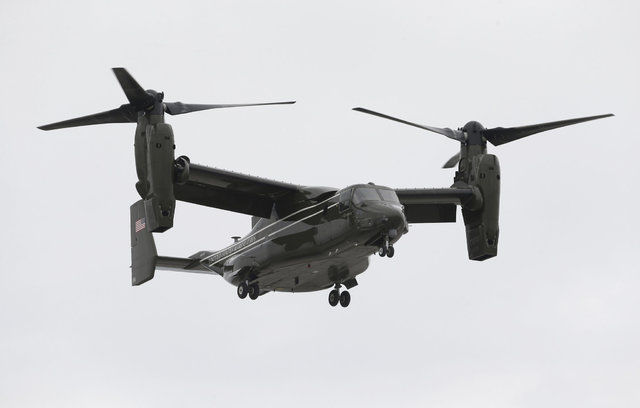BARKING SANDS — The U.S. Marine Corps is considering a re-establishment of two landing zones on Kauai for aircraft training, and residents on the island are demanding more information. The USMC announced the preparation of an environmental assessment in the
BARKING SANDS — The U.S. Marine Corps is considering a re-establishment of two landing zones on Kauai for aircraft training, and residents on the island are demanding more information.
The USMC announced the preparation of an environmental assessment in the Sept. 23 state bulletin of The Environmental Notice, stating their intentions of restarting two landing zones on Kauai and establishing four zones on Niihau.
The purpose is to increase Terrain-Following (TERF) and Confined Area Landing (CAL) training on the islands of Kauai and Niihau for three types of aircraft: CH-53 and H-1 helicopters and the MV-22 Osprey tilt-rotor aircraft.
On Kauai, the USMC is looking at an area in the mountain valleys east of Barking Sands, at a single-aircraft helicopter landing zone at Makaha Ridge, and a four-aircraft landing zone within the TERF route.
“The proposed action is to address the lack of TERF and CAL training areas for USMC tilt-rotor and helicopter aircraft crews in Hawaii,” the announcement said. “These areas have not been used in recent years by the U.S. Marine Corps.”
The three paragraphs explaining the USMC’s plan aren’t telling enough of the story, though, according to some Kauai residents.
“The USMC quietly announced this with a one-month comment period, but with very little specific information,” said Jon Letman, an independent journalist from Lihue. “It’s very difficult for most people to offer well-informed comments.”
Understanding the MV-22 Osprey aircraft’s design and purpose is imperative, Letman said, because the aircrafts are loud. He pointed to Okinawa, where 24 of the aircraft are based in the midst of controversy.
“In Okinawa, the Osprey is widely opposed for safety concerns, noise and because the USMC has conducted Osprey flight training as late as 10 p.m. over small villages,” Letman said.
Katherine Muzik of Kapaa said she has friends in Okinawa who are protesting the “desecration of their forest” due to the construction of six new helipads in a forested area similar to Kokee. The construction of the helipads have “been a topic of extremely fierce opposition from residents in Okinawa,” she said.
Concern for the forests of Kauai is something that Letman said he also thinks could trigger community reaction.
“Kauai should learn from what Okinawa is dealing with and consider it as the Marines announce they want to increase training on Kauai and Niihau,” Letman said.
Using the limited terrain on Kauai for training is “not optimum” in the opinion of Frank Kelly of Koloa, who said the economic and cultural impacts are “incalculable, especially since other, better options exist.”
“The military must have ground where they train and maintain combat readiness, otherwise they are a dull, unreliable tool for our national interests,” Kelly said. “If troops need additional training, they should return to the Mainland and use BLM (Bureau of Land Management) land.”
Arizona, California or New Mexico could offer vast and varied terrain for training, he said.
“The quantity and variety of alternate terrain makes the use of Kauai and Niihau appear crass and insensitive,” Kelly said.
TERF and CAL trainings both involve flying at low altitudes and undertaking practice landings around obstacles. That means the possibility of these aircraft interacting with aviation tour companies and amping up the noise levels.
Learning those details, such as the number of helicopters planned and exactly what kind of construction will be occurring in Kauai’s mountains, is imperative for Rep. Dee Morikawa, D-14.
“The noise is a huge issue and until we know the facts of the plan, it’s hard to comment, but if these training areas occurred on Niihau or at PMRF, I don’t see a problem as long as the Robinsons were OK with it,” Morikawa said.
Bruce and Keith Robinson are the co-owners of Niihau.
An environmental assessment, however, isn’t good enough, Morikawa said. She thinks USMC should do a full and more comprehensive environmental impact statement.
“I have major concerns about landing in remote mountain areas because Kauai has so many protected species in plants and animals,” Morikawa said.
The USMC has yet to respond on the matter despite multiple attempts for comment.
Comments from the public on the potential re-establishment of the Kauai training zones and the addition of four new ones on Niihau will be accepted until Oct. 23.
Written comments can be provided via email to NFPAC-Receive@navy.mil or can be mailed to Project Manager, EA for USMC Aviation Training on Kauai and Niihau, Naval Facilities Engineering Command Pacific, 258 Makalapa Drive, Suite 100, Pearl Harbor, HI 96860.


